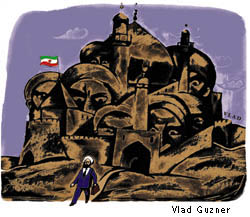
“Something very unusual has happened in Iran,” said Dr. Ian Lustick, professor of political science, at the outset of a seminar sponsored by his department. Lustick was referring to the election of Mohammad Khatami as president last May, which came as something of a shock to the conservative religious forces that had been governing Iran for the last two decades. And one of the results of that election — and the subsequent hints of a thawing of Iranian-American relations — was the very unusual appearance at Penn by Iranian political scientist Moustafa Torkzahrani.
Torkzahrani, a fellow of the Institute for Political and International Studies at the College of Diplomacy in Tehran, is reportedly close to Khatami. His talk — titled, a bit confusingly, “Iran After Khatami: Civil Society and Foreign Policy” — marked the first time that someone from an Iranian institution with government connections has made an appearance in an American forum. (Despite his official invitation, Torkzahrani found himself being fingerprinted and photographed by customs officials when he arrived in New York.) After Torkzahrani spoke, former hostage Bruce Laingen, who had been serving as chargé d’affaires at the American embassy in Tehran at the time of the embassy takeover, offered his view of Iranian-American relations. The two did not share the stage at the same time, however, due to the still-sensitive nature of those relations in Iran.
Although there are still no diplomatic relations between the two countries, there are other signs of a diplomatic warming under Khatami, who has called for “dialogue in place of conflict,” according to Torkzahrani. (At a December news conference, Khatami offered his “respects to the great American people,” and called for a dialogue with them. President Bill Clinton responded by saying that he “would like nothing better than to have a dialogue with Iran, as long as we can have an honest discussion of all the relevant issues.”) One sign of that thaw was the warm reception given to American wrestlers on a recent visit to Tehran.
Torkzahrani noted that when most Americans think about the political tensions with Iran, they harken back to 1979, when Iranian revolutionaries shouting “Death to America” seized the United States embassy in Tehran, taking 66 Americans hostage and holding 52 of them for 444 days. (They might also believe, as does the U.S. government, that Iran has quietly sponsored such terrorist organizations as Hezbollah and Hamas.)
But the Iranian view of American-Iranian tensions goes back to 1953, when the CIA helped topple Prime Minister Mohammad Mosaddeq and install the hated Shah. Iranians also remember some more recent history, such as when the United States supported Iraq in its eight-year war with Iran, even when Saddam Hussein used chemical weapons against Iranians and the Iraqis shot down an Iranian passenger plane carrying innocent civilians. (Torkzahrani said that he himself went completely blind for several months after an Iraqi gas attack, and still suffers from side effects.)
Although there are still powerful conservative forces in Iran, Torkzahrani noted that since Khatami became president there has been much more freedom of speech than under any of his predecessors: “If we compare Iran before Khatami with Iran just a few months after the elections, we find more articles discussing and criticizing foreign policy than appeared in the entire time before Khatami. The mere fact that President Khatami is able to address these different aspects of foreign policy demonstrates his popular support.” And, he added, “it is very important to understand that Khatami emphasizes that opposition groups — including even those who do not believe in the present system — must fully retain their rights as guaranteed by the Constitution.”
Torkzahrani had sharp words for a number of aspects of American foreign policy, including its “dual-containment policy” against Iran and Iraq, which includes economic sanctions against Iran; its “one-sided support for Israel”; and its “double standard” in Afghanistan, where it supports the Taliban, even though that party’s members “abuse human rights and force women to stay at home.” And he was particularly critical of America’s “inconsistent” policy toward Iraq.
“American policy-makers now speak of Saddam’s ‘weapons of mass destruction,’ but the existence of such weapons was already well known at the time” of the Iraq-Iran war, said Torkzahrani. His own opinion is that “we are left with no alternative but to work with Iraq — with this Iraqi regime — as best we can. The people of the region have concluded that, at bottom, America has no regard for their humanity — just oil and Israel.”
The American government, he added, should reconsider its policies on the economic sanctions and release the frozen Iranian assets. Otherwise, “there is no need for the government of Iran to jeopardize its legitimacy for nothing.”
But, he said: “Regardless of their difficulties with the American government, the Iranian people are a civilized people and continue to offer their hospitality to the American people. And when American policy-makers change their behavior, the Iranian people do take notice.”
Laingen, who has retired from the Foreign Service and is now president of the American Academy of Diplomacy, argued that the United States should accept the Islamic Revolution in Iran: “We recognize reality when we see it. It’s now 18 years since I left, and it makes no sense that there are no diplomatic contacts between the United States and Iran. Our governments have begun to lower the rhetoric, but we haven’t thought enough about how to get out of this box and address reality.” He also warned that any dialogue must rest on an appreciation of Iran’s strategic importance and the reality of the United States’s presence in the Middle East.
While he acknowledged he had no “magic solution to impose,” Laingen said he remained “deeply optimistic” about the chances for a rapprochement. After all, he noted, the United States is now the second-largest Persian-speaking country in the world.

